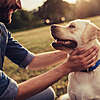GERIATRICS
What is geriatrics?
As our pets age, certain changes take place. Some are obvious, such as locomotor disorders andosteoarthritis. Others may go unnoticed: a tired heart, intestines that no longer absorb nutrients as well as they used to. Their immune systems are less competent and their ability to heal less effective. Old age is not a disease, but older animals require more attention than their younger counterparts.

What issues are discussed during a geriatric consultation?
The view
Pets do not systematically lose their vision as they age. However, certain age-related changes to the eye can reduce visual acuity. Your companion may hesitate before taking the stairs or jumping. He may have difficulty reaching for his toys, or get "stuck" in unlikely places.
Hearing
Very often, you may have the feeling that your pet is deaf, except when he hears his bowl! Hearing loss is common and occurs in the last third of a pet's life, which of course varies according to breed. Although this deafness is progressive, it is sometimes perceived as sudden.
The coat
In addition to the gray hairs that appear around the eyes and on the muzzle, other changes can occur in seniors. Hair can become dull or greasy, with dandruff. This is due to reduced sebum production by the sebaceous glands. Skin loses elasticity, with a tendency to superinfection. Although these chronic infections can cause discomfort for your pet, a major adverse effect is the odor, which sometimes leads to your pet being excluded from the family cocoon.
Locomotion
A lack of mobility is one of the most common symptoms seen in our aging companions. At least 50% of senior pets suffer from locomotor difficulties.
These are linked to osteoarthritis, but also to a lack of muscle mass. Everything becomes more laborious: getting up, jumping, walking on tiles...
Behaviour
Senior pets can develop cognitive disorders, includinganxiety and senility. These changes most often occur in the late afternoon, with incoherent behaviors and vocalizations that can sometimes alter the bond between you.
But what can you do?
Various strategies can be put in place to slow the progression of these pathologies. Simple arrangements such as anti-slip mats or ramps can help your companion. It's also possible to fit an anti-collision harness, or a harness with wrists on the front and back hands to lift your pet and help it climb.
Exercise remains essential, but must be adapted to the animal's abilities. Certain massages can relieve arthritic pain.
Finally, a whole medical arsenal is available to combat osteoarthritis pain, improve anxiety and slow the progression of cognitive disorders.
Why a home vet?
With locomotor difficulties and anxiety increasing with age, what could be better than having the vet come to your home? This also enables us to assess the environment in which your companion lives, so that we can make suggestions for improvements.
Growing old together is a daily challenge, and one that can benefit from outside support. It's a question of taking stock together of the difficulties encountered in your daily life, prioritizing them, and putting in place a feasible strategy to improve cohabitation.


